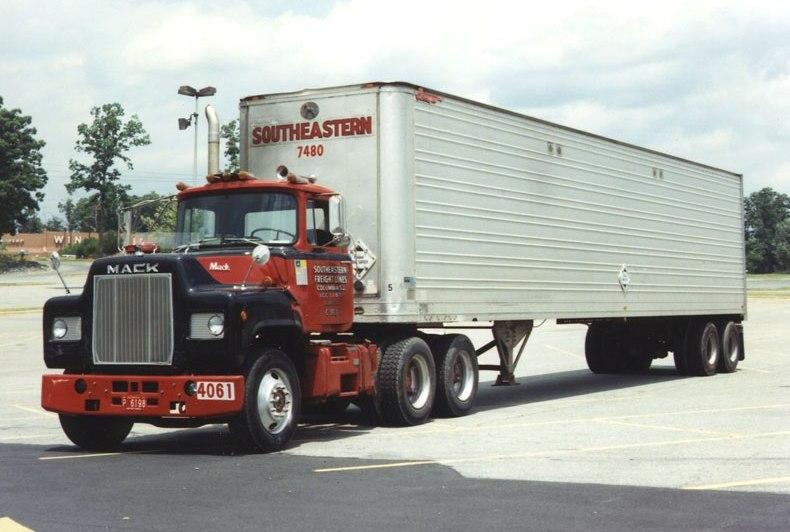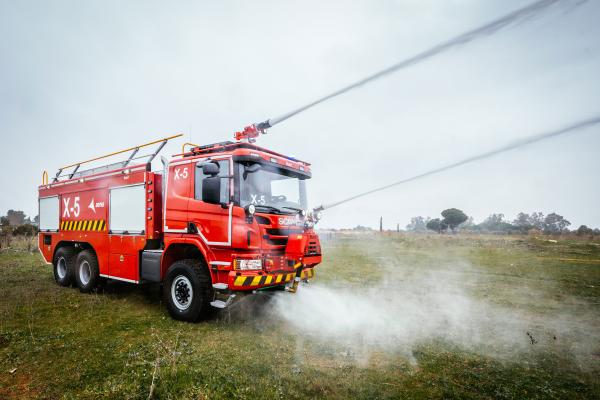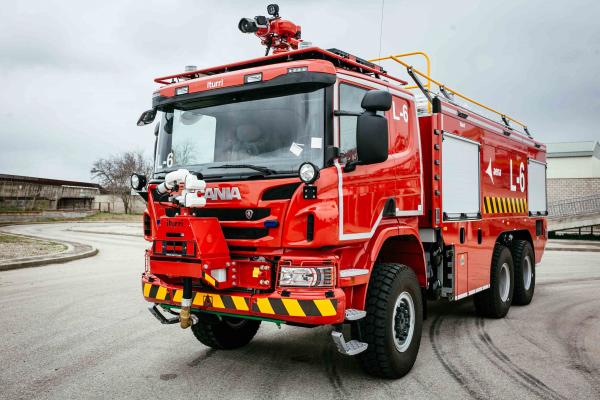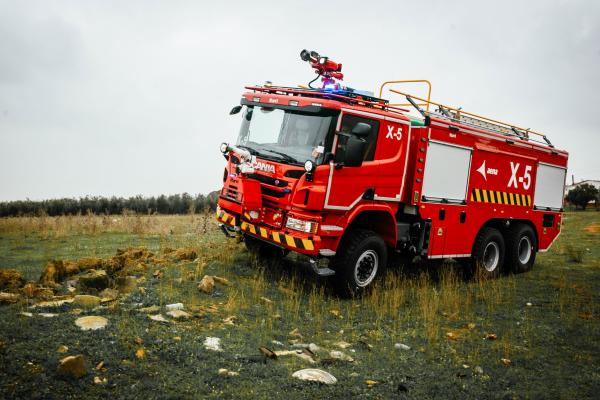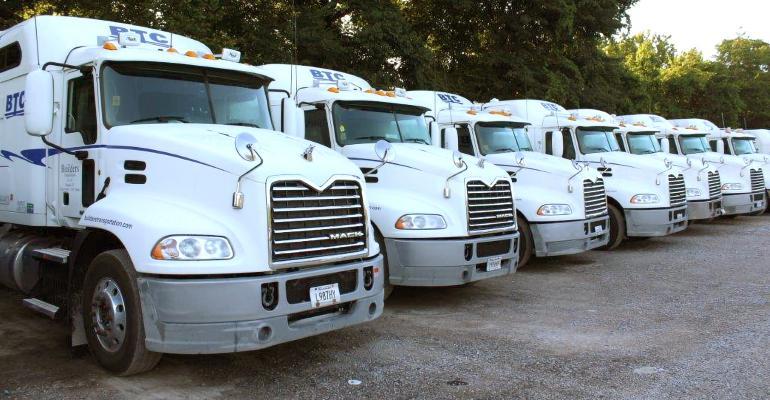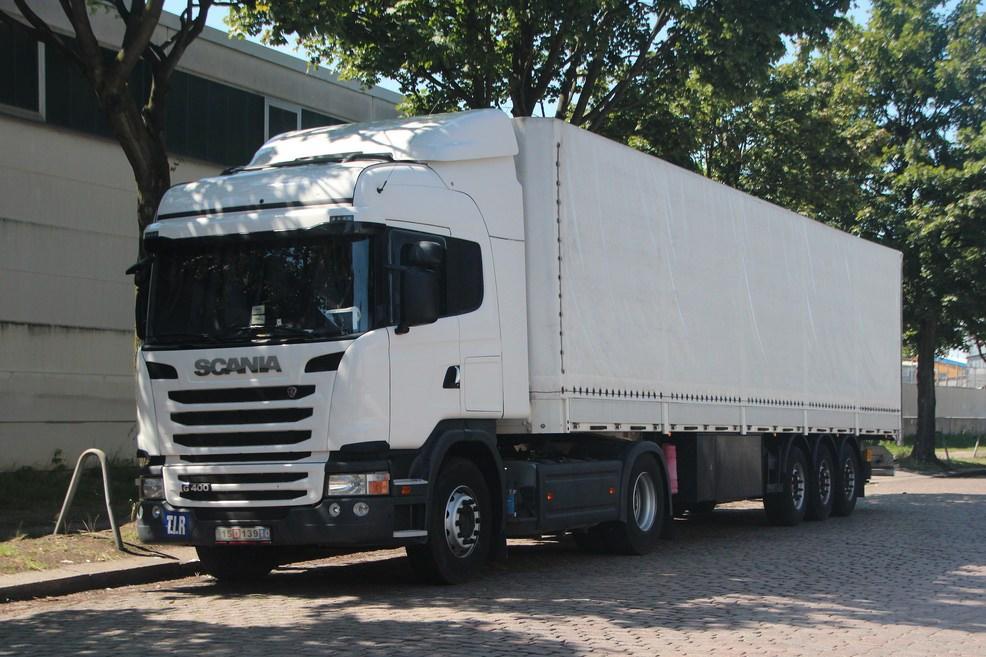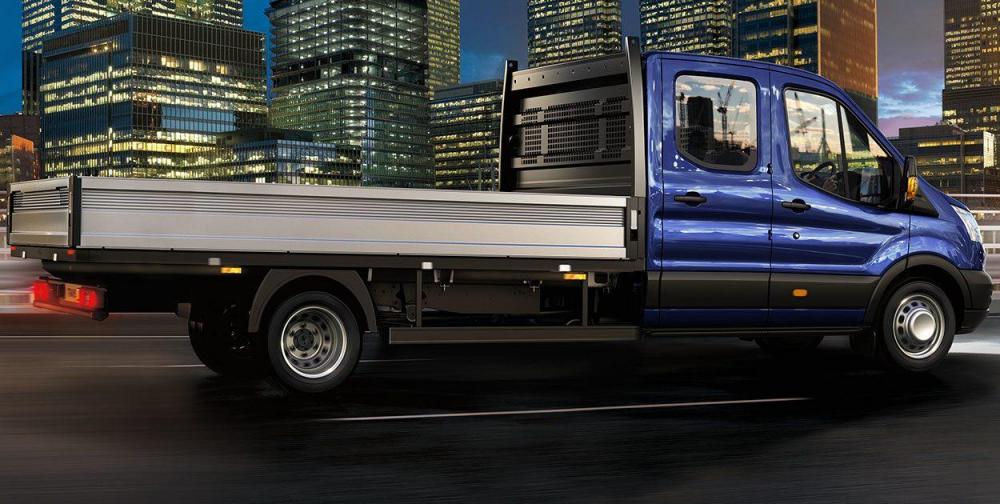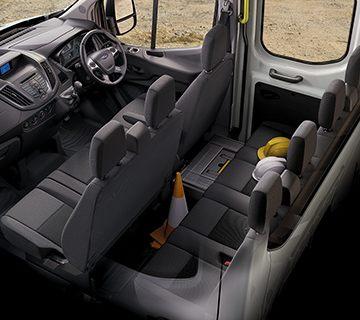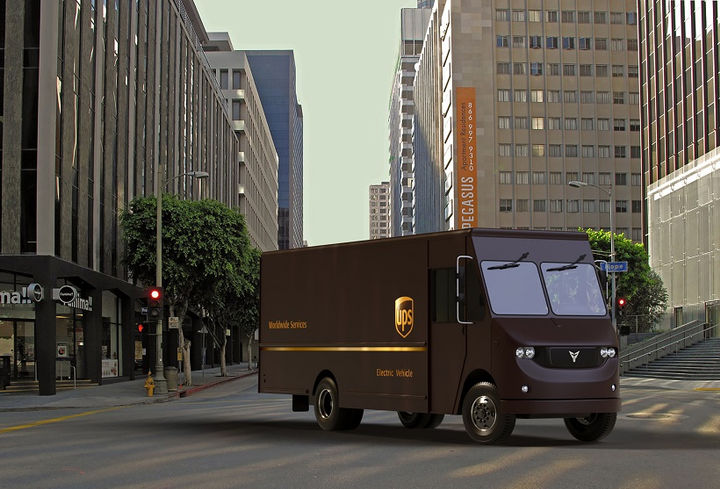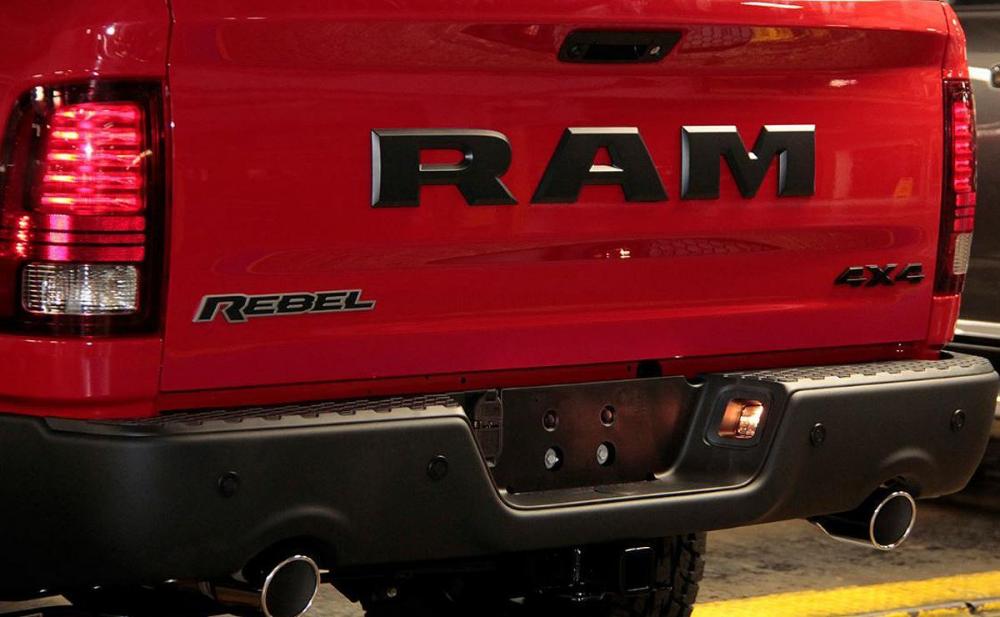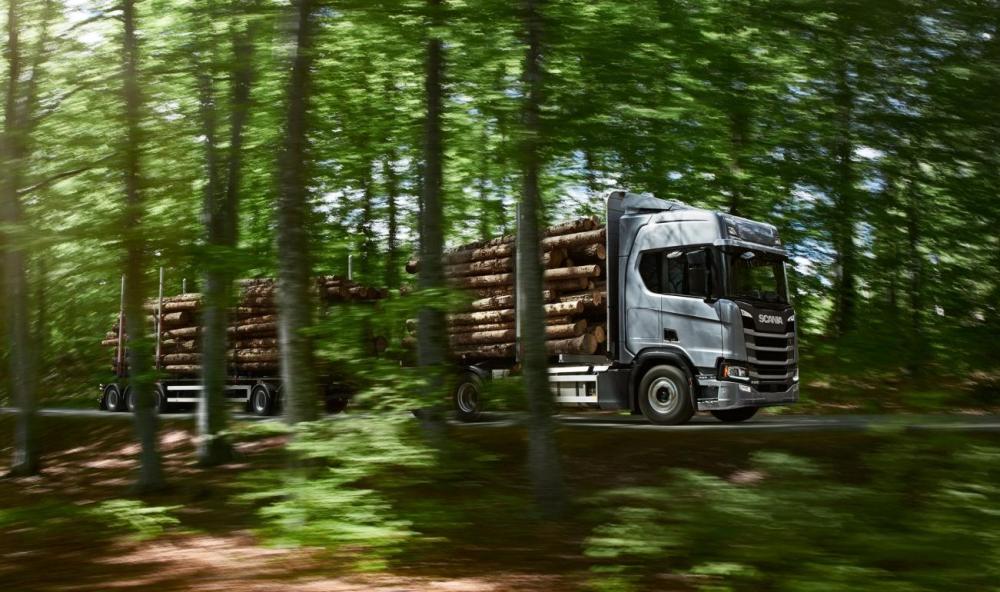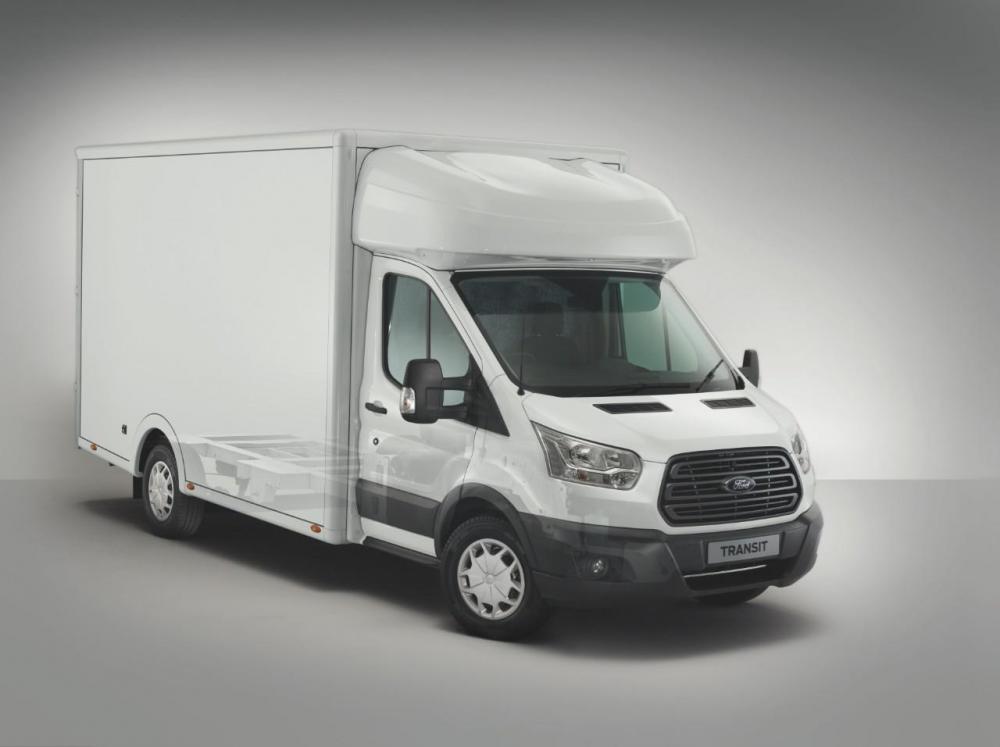
kscarbel2
Moderator-
Posts
18,854 -
Joined
-
Days Won
114
Content Type
Profiles
Forums
Gallery
Events
Blogs
BMT Wiki
Collections
Store
Everything posted by kscarbel2
-
All the Macks I knew with Cherryville (northwest of Gastonia), North Carolina-based Carolina Freight were Mack-powered. They bought some of everything, and ran many White 4000s (local) and 7000s (over-the-road). Winston Salem, North Carolina-based McLean Trucking also ran many makes, including Whites. There was so much trucking going on in North Carolina at one time, we had a factory branch in WInston Salem, in addition to Charlotte, to support the massive fleets up there. We sold the Winston-Salem branch to Jim Bland and Triad Mack was born.
-
Bob, the cabs on the Cummins-powered U-700s were indeed mounted higher for clearance and a larger radiator. When I recall the U-700, I instinctively think of Columbia, South Carolina-based Southeastern Freight Lines. They had NHs, not 903s. .
-
Ford unveils new Transit skeletal chassis cab
kscarbel2 replied to kscarbel2's topic in Trucking News
I think you'll find that what works in Europe, the global market, can work here. Towing needs to be regulated. A CDL-less 16-year-old kid barreling down a crowded 45mph road doing 55mph in an (insufficiently tow rated) E-250 or F-250 pulling a cheap and overloaded tandem-axle trailer overloaded with a skid loader, breaker and numerous other items that he failed to secure properly (aka. projectiles) is all too common place. These accidents-waiting-to-happen are seen daily coast-to-coast. Such towing should be limited to private property (at your own risk), and banned from public roads. In the 550 range, I'd like to see a (Cargo) low-cab-forward. With that you get the needed weight distribution, with the added benefit of enhanced visibility. -
Scania Group Press Release / August 3, 2018 Spanish airports giant adds 14 new firefighting trucks to its emergency fleet. AENA, the Spanish airports authority, has made a significant reinforcement to its firefighting and emergency capabilities with the addition of 14 Scania P 490 6×6 fire trucks. Each of the vehicles is equipped with a 13-litre Scania engine, and nine of the trucks have superstructures built by Iturri, while five have been built by Rosenbauer. Ideally equipped for all airport emergencies According to Eurostat, Spain had the third-largest volume of airport traffic in 2017 (after the UK and Germany), with almost 250 million passengers. And for AENA, which counts 46 airports and two heliports in its national network, the Scania P 490 6×6 is ideally equipped for fighting fires and dealing with other airport emergencies safely and quickly. The new firefighting truck measures up to the stringent specifications that are required by the International Civil Aviation Organisation (ICAO). Crucially, the vehicle has rapid speed of response. When fully loaded it can accelerate from 0 to 80 km per hour in less than 35 seconds, and it has a maximum speed of 100 km per hour. The firefighting capability is also impressive. It includes a 6,100-litre water tank, a foam tank with a storage capacity of 750 litres and a chemical dust deposit of 225 kilos. The truck also has a water cannon mounted on the ceiling of the cabin that can provide a variable jet for spraying water and foam, at a distance of more than 65 metres. A secondary front cannon under the windscreen has a range of 40 metres. .
-
Eaton’s new Endurant transmission - Don’t call it an AMT
kscarbel2 replied to kscarbel2's topic in Trucking News
Cummins, Eaton joint venture expected to profit in 2020 Truck News / August 3, 2018 COLUMBUS, Indiana – A Cummins and Eaton joint venture that was developed in 2017 is expected to be profitable by 2020, Cummins president and chief operating officer Richard Freeland said when releasing financial results for the second quarter of 2018. Current losses for Eaton Cummins Automated Transmission Technologies are expected to be halved in 2019, with a break-even point to be reached the following year. “The combined powertrain product is doing terrific as we introduced the new product, and more importantly, as we’ve done the integration work between the engine and the transmission,” he said. The first product to emerge through the joint venture was the 12-speed automated Endurant transmission. It isn’t the only partnership playing a role in future business plans, either. Cummins, which recently acquired Efficient Drivetrains Inc. as part of its electrification strategy for commercial vehicles, is also forming a joint venture with Chinese JAC Motors following Navistar’s exit from that business. Tom Linebarger, Cummins chairman and chief executive officer, says the company will benefit from JAC’s strong exporter status in overseas markets that follow China 6 emissions standards. Cummins’ market share in the region is expected to grow significantly – perhaps double – in five years, he said. -
Not to be confused with Atlanta-based Builder's Transport, which was acquired by Green bay-based Schneider National in 1998.
-
Fleet Owner / August 3, 2018 Flatbed and specialized transportation provider Daseke, Inc. has acquired Memphis-based metal hauler Builders Transportation Co. The purchase adds Builders' fleet of more than 300 trucks and nearly 500 spread-axle trailers to Daseke, which already is the largest company of its kind in North America with a combined fleet of over 5,200 trucks and 11,000 flatbed and specialized trailers. Builders' traditional flatbed operations through the 48 contiguous states are focused in the eastern two-thirds of the U.S. hauling coil steel, wire products, structural and sheet steel, aluminum products, building materials, cast iron, steel pipe, and machinery. "We've had Builders Transportation on our radar for quite some time. We've been impressed with the focus and family-rooted culture of the company," said Don Daseke, CEO of Daseke. "The company has been in business since 1954 and it has a long legacy as a family-run operation. They will be a great addition to the Daseke family." For the 12-month period ending in June 2018, Builders had an estimated $72.4 million in gross revenue and $9.7 million in adjusted EBITDA. Under the terms of the purchase agreement, Daseke acquired Builders for a total consideration of $53.8 million including $3.4 million in Daseke stock. Builders has won "Carrier of the Year" awards from several of its core customers, the company noted. It has been family owned and operated since Frank Phillips Sr. purchased the six-truck operation back in 1961, and along with his sons has steadily grown the business to where it is today. "Over the years, we've had companies approach us but we never took any of that seriously—we didn't want to give up what our family has built,” said Builders CEO John Phillips. "We have a long history and are very protective of our heritage. We have people here who have been with us their entire career. Being with Daseke lets us continue being who we are, and that's critically important to us." Investment analysis and equity research firm Cowen issued a brief today on the Builders acquisition stating it believes there will be "moderate synergies from the deal" with Daseke seeing moderate per-share earnings growth next year. "We view the acquisition as part of [Daseke's] ongoing plan to roll up the heavyweight and transport sectors," Cowen stated in the brief. .
-
Scania says U.S. sanctions put entire Iran truck sales in 'jeopardy'
kscarbel2 replied to kscarbel2's topic in Trucking News
"When I ran Mack International, we averaged sales of 4,000 to 4,500 trucks per year in 1975-79 in Iran (7,000 units in 1975)," Curcio said. "At that time, Iran Drilling was one of our customers. I'm sure they've missed the strength, longevity and reliability of a Mack. We still have between 35,000 and 55,000 Mack trucks operating in Iran." Mack Trucks Chairman John B. Curcio -
Reuters / August 3, 2018 Scania’s entire sales into Iran could be lost if the United States reinstates sanctions against the country, the Swedish truckmaker’s head warned on Friday, a day after first-half results showed the company’s Iranian order book was already being hit. CEO Henrik Henriksson said Scania, which was one of the first truck companies to return to Iran after the EU lifted sanctions in early 2016, had cancelled all orders that it could not deliver by mid August as anything after would have been hit by the new sanctions. “Looking at the information we have on hand today, of course if nothing is improving, then (our) whole volume will be in jeopardy,” told Reuters. Among truckmakers, Scania, has one of the larger presences in Iran, selling 5,000-6,000 trucks and buses annually, according to Henriksson. That represents about 5 percent of its global vehicle orders of 109,415 last year. Such a move would be another blow to the Iranian car industry, which unlike the energy and banking sectors, had managed to sign contracts with top European firms after the lifting of sanctions in 2016, attracting sizable foreign investment. French carmaker PSA Group began to suspend its joint venture activities in Iran in June and Germany’s Daimler said it was closely monitoring any further developments and would then evaluate the potential impact on its business. Despite the efforts of European governments to salvage the nuclear deal and provide guarantees to European firms to protect them against secondary U.S. sanctions, many of them are leaving Iran anyway to avoid any possible U.S. penalties. America accounted for 13 percent of Scania’s orders for trucks, buses and coaches in 2017. Scania declined to comment on how much of an impact the decline in orders from Iran, considered as one of their growth markets, had on first half results. The company’s factories in Latin America and Europe are used to produce vehicles for Tehran and it distributes trucks and buses through local partners, which also own Scania’s production and extensive servicing network in Iran. Henriksson said Scania was also pressing for faster payment as sanctions could potentially close financing networks by November. “As it is right now, it’s a wind down window of getting orders out that were in before a certain date and getting payments in as much as you can,” he said. However, Henriksson said Scania was working on a contingency plan so that it could continue to deliver spare parts needed to keep its trucks and buses on Iranian roads running, but that nothing was resolved yet. .
-
Billy, the sum of kickbacks from truckmakers into the pockets of trucking company executives over the years runs into the billions of dollars, and Roadway was no exception.
-
Ford unveils new Transit skeletal chassis cab
kscarbel2 replied to kscarbel2's topic in Trucking News
The dropside bed is functional/versatile. Our archaic fixed shape pickup beds offer no such flexibility. The crew cab Transit dropside pickup is so much more efficient in form and function than a typical US conventional cab pickup. Weight distribution is far better. No fuel guzzling engine. More maneuverable. A spacious cab designed for work. Unparalleled visibility. The list goes on and on. -
Ford unveils new Transit skeletal chassis cab
kscarbel2 replied to kscarbel2's topic in Trucking News
https://www.ford.com.au/commercial/transit-cab-chassis/?gmbxtid=ford_transit_first-kba-001-transit_cab_chassis_1 . . -
Class 8 Orders in July Reach All-Time High of 52,400
kscarbel2 replied to kscarbel2's topic in Trucking News
The driver shortage is fiction, to jack up rates and profits over the summer. Look at lumber. It shot up in June under the excuse of a truck (driver) shortage. But in fact there hasn't been a supply shortage because truck shipments have been adequate. Now watch lumber prices will fall back down by the end of this month. This is how the lumber distributors make extra money. -
UPS to Test Fully Electric Thor Delivery Truck Heavy Duty Trucking (HDT) / August 2, 2018 UPS and electric truck maker Thor Trucks are collaborating on a fully electric Class 6 to be developed and tested in Los Angeles. The truck is expected to be ready to deploy later this year, according to UPS. It will have a driving range of approximately 100 miles and is powered by a Thor-designed and built battery made to be lightweight and durable. The plan is for UPS to test the medium-duty delivery truck in in fleet operations for six months. Testing will include both on- and off-road evaluations where aspects such as durability, battery capacity, and technical integration can be studied. “UPS is committed to sustainability and operates one of the most well-respected and complex fleets in the country,” said Dakota Semler, co-founder and CEO of Thor Trucks. “This is also an incredibly valuable opportunity to gain insight into what it will take to fulfill our mission of getting entire electric fleets on the road.” This is the latest project to be announced as part of UPS’s Rolling Laboratory approach that deploys low-emissions vehicles in the real world to determine what technology works best on each route. So far the company has 9,300 low-emissions vehicles including all-electric, hybrid electric, compressed natural gas, and other alternative powertrain types. On the electric vehicle front, UPS is working with several manufacturers including Arrival, Daimler, Tesla, Thor, and Workhorse. As a company UPS has announced several initiatives to lower its environmental impact. It has a 2020 goal of making one in four new vehicles purchased an alternative fuel or advanced technology vehicle. The company also set a goal of replacing 40% of all ground fuel with sources other than conventional gasoline and diesel. Ultimately, UPS has committed to reducing its greenhouse gas emissions from global ground operations 12% by 2025. “UPS believes in the future of commercial electric vehicles. We want to support the research needed to make advances and the companies developing those innovative products,” said Carlton Rose, president, global fleet maintenance and engineering for UPS. “Performance is critical in our fleet." .
-
Transport Topics / August 2, 2018 Class 8 orders in July set an all-time monthly high and soared past 52,000 as the crush continues. Orders hit 52,400, based on a preliminary figure that will be adjusted when final data is out. The previous record was 52,194 set in March 2006. “July’s activity was nearly triple that of July 2017,” an analyst said. A year earlier, orders were 18,726. “The feat is made even more spectacular since July typically is the weakest order intake month of the year,” he said. Orders in the first seven months are nearly 222,000. One analyst pointed to the activity among dealers trying to stock up. “The [truck makers] are opening up their production schedules for next year, and the strength in orders is coming from dealers as they are preparing for a strong 2019 and have been frozen out of build schedules for this year — over 90% of the orders in June were for 2019,” Credit Suisse analyst Jamie Cook wrote in a note. At the same time, carriers are posting record profit margin as the broader environment for the trucking industry remains strong, she said.
-
Daimler to split business into cars, trucks, mobility units
kscarbel2 replied to kscarbel2's topic in Trucking News
Daimler AG’s Board Approves Restructuring Aimed at Mastering Rapid Change Transport Topics / July 27, 2018 Daimler AG announced its board has approved a restructuring, first discussed in 2017, that would create three independent units under Daimler’s umbrella as a holding company after the most thorough due diligence in the company’s 130-year history. The final step involves shareholders approving the reorganization, known as Project Future, at the company’s next annual meeting, scheduled for May 2019. The restructuring, once approved, is set to be completed by Jan. 1, 2020. “The new structure positions Daimler to tackle the rapid pace of change in the mobility sector and the corresponding strategic challenges. Legally independent divisions will sharpen our focus on the future success of the business,” Daimler Chairman Manfred Bischoff said in a statement. The new divisions will be more entrepreneurial, positioned closer to their markets and customers, and empowered to enter partnerships more easily and quickly, according to the Stuttgart, Germany-based company. In the realignment of the world’s largest vehicle manufacturer, Mercedes-Benz AG will include the Mercedes-Benz cars and vans divisions, and have 175,000 employees. The car segment is the company’s largest business. Daimler Truck AG will include its trucks and buses operations, and have 100,000 employees. The truck unit is the largest commercial vehicle manufacturer in the world. Daimler Mobility AG will include the financial services unit, which already was independent, and have 13,000 employees. Three trucking industry analysts agreed with the need for speed. Large companies struggle to move quickly because they have a great deal of inertia tied to supporting existing product lines and manufacturing systems, Rick Mihelic, president of Mihelic Vehicle Consulting, told Transport Topics. “New market opportunities tend to start out with very small sales volumes and unknown market potential. These can suffer when competing for attention next to established products with known volumes and cash flows” at the large companies, he said. At the same time, smaller companies, and especially new entrants and start-ups, are not encumbered by the need to support the existing business models while chasing new ones, Mihelic said. “These companies need cash flow from new products and are inspired to move much more quickly on new technologies. “The ideal world would combine the skills and assets of the established large [companies] with the nimble innovation and energy of the smaller start-ups. I think Daimler is recognizing this by stressing the need to rapidly enter partnerships.” Steve Tam, vice president of ACT Research Co., said Daimler’s proposed new structure “allows for more rapid, nimble response to the ever-developing technology in each of the markets.” Earlier, he said that while autonomy probably is going to be pretty similar across the car and commercial vehicle platforms, electrification may not be. “From an electrification perspective, I think we are going to end up potentially with different solutions, especially in the heavier end of commercial vehicles,” Tam said, adding, Daimler is “at the front of the pack in electrification and autonomous trucks. So this just affords them more rapid response.” John Blodgett, vice president of sales at MacKay & Co. said, “I think we have seen so many announcements in the mobility area in last 12 months that it reinforces the need to have a structure which allows divisions to be more nimble.” Meanwhile, the new structure will involve reassigning more than 700 subsidiaries in over 60 countries. Daimler will exercise corporate governance, strategy and management functions, and provide cross-divisional business services and ensure that synergies between the entities remain as before. Responsibility for the funding of the entire group will continue to rest with Daimler, which will be the only company in the corporate group to be listed on the stock exchange. As part of the planned overhaul, Daimler extended a labor pact that rules out forced layoffs until 2030 and will allocate 35 billion euros ($41.2 billion) in investments on electric cars and other new technologies over the next seven years, the group’s workers council told Bloomberg News in 2017. The manufacturer also is contributing 3 billion euros to its pension plans. The overhaul, first proposed in July 2017, would be Daimler’s biggest corporate revamp since it ended its ambitions of becoming a global car giant with the sale of Chrysler a decade ago. -
Ford unveils new Transit skeletal chassis cab
kscarbel2 replied to kscarbel2's topic in Trucking News
I'm speaking of the full-size Transit. Aside from Valencia, Ford-Otosan remains a major Transit Connect producer. Aside from Nanchang (just started), Ford-Otosan is the exclusive production base for the mid-sized Transit Custom/Transit Tourneo. -
Ford unveils new Transit skeletal chassis cab
kscarbel2 replied to kscarbel2's topic in Trucking News
In 2001, I had a long discussion with Ford engineers in Nanchang about why the superior Transit had yet to supercede the Econoline in North America. In short, it was because Americans "tow", and Europeans don't (not like Americans do). The Transit had not been designed for the ridiculous towing people do wlth light trucks in the states. I'm talking about unqualified drivers operating vans and pickups towing cheap, mammoth, overloaded tandem axle trailers. -
Ford unveils new Transit skeletal chassis cab
kscarbel2 replied to kscarbel2's topic in Trucking News
Chinese (Jiangling) and Russian (Sollers) production is also only rear-wheel-drive. In Europe, the ability to order front-, rear- or all-wheel drive is a real selling point. Here's another example of how important Ford-Otosan is to the Blue Oval's worldwide game plan. Aside from the Americas, China and Russia, Ford-Otosan is responsible for all Transit production. -
White House proposes weaker auto emissions rules, overriding California Eric Kulisch, Automotive News / August 2, 2018 WASHINGTON -- The Trump administration on Thursday proposed capping federal fuel efficiency requirements for passenger vehicles at the 2020 model year level of 35 mpg, instead of letting them continue to rise through 2025 to about 50 mpg as planned under the Obama administration. The notice of proposed rulemaking also declared that the 1975 law that established fuel efficiency standards pre-empts California from setting its own carbon emission standards for vehicles and that a waiver from federal rules allowing it to set stricter standards on its own should be revoked -- setting up a likely court clash. The draft rule, jointly written by the EPA and NHTSA, includes a range of options for modifying the fleet fuel economy and emissions standards, but makes clear the preference is to freeze the standards at the 2020 model year level. The new plan, if adopted in a final rule after a public comment period, would dramatically weaken President Barack Obama’s most far-reaching policy intended to reduce greenhouse gas emissions that contribute to climate change. The Thursday move, widely anticipated, was quickly criticized by environmentalists and lawmakers from several states. California Gov. Jerry Brown said his state "will fight this stupidity in every conceivable way possible." Trump embraces automakers The effort began early last year after President Donald Trump embraced automakers’ appeals to relax the aggressive standards and make compliance more manageable. In the spring, former EPA Administrator Scott Pruitt determined that the Obama administration’s five-year re-evaluation of whether the 2021-25 model year standards were still feasible was faulty and ordered a new review. Under existing rules, standards vary by model based on a size footprint. A Honda Fit, for example, would need to get 62 mpg by the 2025 model year, while a Chevy Silverado would comply with 35 mpg. Automakers got more than they bargained for when Pruitt, a self-professed “small-government” champion, pushed for a significant rollback of the fuel economy standards and revoking California’s waiver. There are differences among the major companies over how much the phased-in standards to which they agreed in 2012 should be watered down. But the consensus is for rules that California can accept so that the state, and a dozen others that follow its program, continue to participate in a harmonized national program. Without a unified program, automakers face the expensive prospect of building and marketing vehicles for two markets or losing sales of some models in certain states. "We applaud the president and the administration for releasing this much anticipated proposal that includes a variety of standards for public consideration," the Alliance of Automobile Manufacturers and the Association of Global Automakers said in a statement. "Automakers support continued improvements in fuel economy and flexibilities that incentivize advanced technologies while balancing priorities like affordability, safety, jobs, and the environment. "With today’s release of the Administration’s proposals, it’s time for substantive negotiations to begin." 'Common sense solution' The statement urged California and the federal government "to find a common sense solution that sets continued increases in vehicle efficiency standards while also meeting the needs of America’s drivers.” Pruitt did not see the proposed rulemaking to its conclusion, having resigned last month under pressure for a series of ethical and management lapses that brought negative attention on the White House. Acting Administrator Andrew Wheeler, a former fossil fuel and coal industry lobbyist who once worked for climate-change denier Sen. James Inhofe, R-Okla., reportedly worried that the proposal was legally and technically weak, making it vulnerable to rejection in court. At a Senate hearing Wednesday he encouraged the auto industry and California to find a compromise that would enable continuation of a single national program. The draft rule contends that the existing rules are too costly and would lead to production of lighter cars, resulting in about 12,000 more traffic fatalities over a dozen years, primarily because vehicles will be cheaper and encourage consumers to replace their older vehicles and buy newer, safer cars. Consumers may delay or forgo the acquisition of safer vehicles as a result of higher prices associated with clean car and safety technologies, the rulemaking says. More consumption The freeze would increase U.S. oil consumption by about 500,000 barrels of oil per day by the 2030s. It also argues that people will drive less with cars that burn more fuel, further protecting them from potential accidents. Critics say the administration based its decision on ideology, with thin data to justify weakening the emissions rules, compared with the voluminous scientific record developed by the Obama EPA. California and its allies previously threatened to sue the federal government if the corporate average fuel economy rules are rolled back. Protracted litigation is likely over the stringency of the fuel economy rules, a determination that California is pre-empted by the Environmental Protection and Conservation Act from regulating carbon emissions from autos and moves to revoke California’s waiver from federal standards, according to stakeholders and experts. Fifty-one House Democrats last week signed onto a resolution supporting the clean car standards and defending state authority under the Clean Air Act to protect their citizens from harmful air pollution. Senate Democrats have also criticized the administration's decision. The government said it will hold three public hearings in Washington, Detroit and Los Angeles to gather input on the proposals, with dates to be determined.
-
FCA recalls more than 1.1 million Ram pickups, citing tailgate latch risk Alexa St. John, Automotive News / August 2, 2018 Fiat Chrysler Automobiles is recalling an estimated 1.1 million Ram pickups in the U.S. to upgrade their tailgate locking mechanisms. The automaker Thursday said the power locking mechanisms in the tailgates of certain pickups have a small internal component that may break over time. FCA said 1,149,237 U.S. vehicles have the defect. The recall affects Ram 1500, 2500 and 3500 pickups from the 2015 through 2017 model years, the automaker said. The trucks have a power locking tailgate and either a 5-foot, 7-inch, or 6-foot, 4-inch bed. "If the tailgate latch releases and the tailgate opens while driving, cargo may fall out, creating a road hazard and increasing the risk of a crash," the company's NHTSA filing states. Another 260,315 vehicles are subject to recall in Canada, along with 19,432 in Mexico and 25,361 in other markets. FCA opened an investigation as a result of customer complaints related to the tailgate falling open while driving or stationary on May 8, the safety recall report states. Through May, June and July, FCA analyzed and verified all known incidents related to the problem. As of July 13, FCA identified 5,643 warranty claims and repair orders potentially related to the problem. FCA on July 19 decided to issue the recall. The automaker said no injuries or accidents have been reported. Customers will be notified when service is available, the automaker said. In the meantime, FCA said customers may use "alternate features to accommodate load security, including tie-down rings, cleats, high-friction bed-liners, bulkhead dividers and bed-extenders." Trucks with manual tailgate locks, with eight-foot-cargo beds, are not included in the recall. The redesigned 2019 Ram 1500 is also not included. The recall is expected to begin Sept. 14. .
-
Ford unveils new Transit skeletal chassis cab
kscarbel2 replied to kscarbel2's topic in Trucking News
The town of Dagenham, Essex County (East London), UK Bob, are the global market front-wheel-drive and all-wheel-drive Transit variants even available in the US market? -
Scania Group Press Release / August 2, 2018 Scania increased its net sales to a record high SEK 66.2 billion in the first six months of 2018, an increase of 9 percent compared to the previous year. Summary of the first six months of 2018 Operating income rose to SEK 6,950 m. (6,464) Net sales increased by 9 percent to SEK 66,228 m. (60,541) Cash flow amounted to SEK -1,157 m. (3,290) in Vehicles and Services As from 2018 Scania’s presentation of the income statement has been adjusted to align with Volkswagen Group’s (including comparative periods) Comments by Henrik Henriksson, President and CEO “Scania increased its net sales to a record high SEK 66.2 billion in the first six months of 2018, an increase of 9 percent compared to the previous year. Earnings amounted to SEK 6,950 m., which gave an operating margin of 10.5 percent. Higher vehicle and service volume contributed positively and so did currency effects while a less favourable market mix, higher production costs for running double product ranges and continuing constraints in the supply chain impacted earnings negatively. The recent strained situation in the supply chain was aggravated by a strike at a component supplier, which means that Scania has been temporarily forced to stop deliveries and sales of V8 engines. As a result of these disruptions, inventory levels have increased, and combined with the high investment level impacts negatively on cash flow. Demand for trucks remains strong in most markets, driven by the automotive, mining, forestry and agricultural sectors, among others. Demand for trucks in Europe remains at a high level. In Latin America, the demand trend is reflected by the slow recovery in Brazil. In Eurasia, order bookings are still at a good level, mainly driven by Russia. Order bookings in the Middle East have decreased due to the reintroduction of sanctions in Iran. In the rest of Asia, the trend is positive driven by the continuing development towards more modern logistics systems. Demand for Buses and Coaches continues to be strong. In the business area Engines, demand is reaching new record levels and the trend is positive in all segments. Financial Services reported operating income of SEK 665 million and credit losses remain at low levels. There is high capacity utilisation in customer vehicle fleets and service revenue amounted to a record high SEK 13.1 billlion in the first half of 2018, an increase of 12 percent. Digitalisation and connectivity are critical in the shift towards a sustainable transport system and constitute increasingly important elements in Scania’s service offering. Using digitalisation, we can improve the efficiency of our own service business through better capacity utilisation in workshops and thus offer customers more efficient service to enhance their profitability. Meanwhile, digitalisation also opens up for new business models, such as Scania Go, a recently launched mobility service. Through a single app, Scania’s employees are given access to a range of different modes of transport during the working day as an alternative to the private car. The aim is to promote sustainable and shared travel and to explore the potential of the system in a broader, commercial perspective.” .
-
Ford unveils new Transit skeletal chassis cab
kscarbel2 replied to kscarbel2's topic in Trucking News
New Ford Transit Skeletal Chassis Cab Delivers Low Load Floor for Easier Deliveries and 200 kg Additional Payload Ford of Europe Press Release / July 27, 2018 New Transit chassis cab derivative with a special low-height chassis is ideal for conversions requiring a low load floor for easy access Skeletal chassis also delivers 200 kg weight saving over standard chassis cab for enhanced payload and reduced cost of ownership Transit skeletal chassis cab is available to order now from Ford’s network of 950 Transit Centres across Europe COLOGNE, Germany – Ford is introducing a new Transit skeletal chassis cab derivative that provides commercial vehicle customers with a versatile low-height platform for a wide variety of body conversions – ideal for applications ranging from general delivery and distribution to removals. Available to order now from Ford’s European network of Transit Centres, the new skeletal Transit offers a chassis height that is 100 mm lower than the standard front-wheel drive chassis cab model, delivering easier access to the load floor with a lower step height, and removing the need for a separate tail lift. With a 200 kg weight reduction compared to the equivalent chassis cab, the optimised design of the skeletal chassis also provides operators with a significant payload advantage – particularly in combination with lightweight body conversions – in addition to the potential for enhanced fuel efficiency. The skeletal chassis derivative will build on the success of the Transit two-tonne model, which continues to generate increased demand in Europe. The Transit has achieved sales of 52,100 during year-to-date June 2018, a 13 per cent increase over the previous year. “Ford’s Transit is already legendary for its huge range of body styles, drivelines and size variants, and this new model takes our offering a significant step further,” said Hans Schep, general manager, Commercial Vehicles, Ford of Europe. “The new Transit skeletal chassis opens up exciting new opportunities for grocery delivery vehicles and other low-floor body conversions where ease of access is paramount.” The skeletal chassis model is based on a front-wheel drive Transit platform, and features an open-backed cab design that supports easy walk-through from the cab to the load space of the converted body. Customers can specify a choice of three different wheelbase lengths to suit a variety of body conversions, with a wide-track rear axle for the longest variant and an optional wide-track rear axle for the 2 shorter variants. All versions offer a gross vehicle mass of 3.5 tonnes. The Transit skeletal chassis derivative is offered with Ford’s powerful and fuel efficient 2.0litre EcoBlue diesel engine in 130 PS or 170 PS outputs, paired with a standard six-speed manual transmission.* Customers can also choose a six-speed automatic transmission, ideally suited to urban delivery applications. # # # * Officially homologated fuel-efficiency and CO2 emission figures will vary according to customer-derived specification The declared Fuel/Energy Consumptions, CO2 emissions and electric range are measured according to the technical requirements and specifications of the European Regulations (EC) 715/2007 and (EC) 692/2008 as last amended. Fuel consumption and CO2 emissions are specified for a vehicle variant and not for a single car. The applied standard test procedure enables comparison between different vehicle types and different manufacturers. In addition to the fuel-efficiency of a car, driving behaviour as well as other non-technical factors play a role in determining a car's fuel/energy consumption, CO2 emissions and electric range. CO2 is the main greenhouse gas responsible for global warming. From 1 September 2017, certain new vehicles will be type-approved using the World Harmonised Light Vehicle Test Procedure (WLTP) according (EU) 2017/1151 as last amended, which is a new, more realistic test procedure for measuring fuel consumption and CO2 emissions. From 1 September 2018 the WLTP will fully replace the New European Drive Cycle (NEDC), which is the current test procedure. During NEDC Phase-out, WLTP fuel consumption and CO2 emissions are being correlated back to NEDC. There will be some variance to the previous fuel economy and emissions as some elements of the tests have altered i.e., the same car might have different fuel consumption and CO2 emissions. About Ford Motor Company Ford Motor Company is a global company based in Dearborn, Michigan. The company designs, manufactures, markets and services a full line of Ford cars, trucks, SUVs, electrified vehicles and Lincoln luxury vehicles, provides financial services through Ford Motor Credit Company and is pursuing leadership positions in electrification, autonomous vehicles and mobility solutions. Ford employs approximately 202,000 people worldwide. For more information regarding Ford, its products and Ford Motor Credit Company, please visit www.corporate.ford.com. Ford of Europe is responsible for producing, selling and servicing Ford brand vehicles in 50 individual markets and employs approximately 54,000 employees at its wholly owned facilities and approximately 69,000 people when joint ventures and unconsolidated businesses are included. In addition to Ford Motor Credit Company, Ford Europe operations include Ford Customer Service Division and 24 manufacturing facilities (16 wholly owned or consolidated joint venture facilities and eight unconsolidated joint venture facilities). The first Ford cars were shipped to Europe in 1903 – the same year Ford Motor Company was founded. European production started in 1911. .
BigMackTrucks.com
BigMackTrucks.com is a support forum for antique, classic and modern Mack Trucks! The forum is owned and maintained by Watt's Truck Center, Inc. an independent, full service Mack dealer. The forums are not affiliated with Mack Trucks, Inc.
Our Vendors and Advertisers
Thank you for your support!


